Strategic IT Management | Report
VerifiedAdded on 2022/09/09
|13
|2400
|17
AI Summary
Contribute Materials
Your contribution can guide someone’s learning journey. Share your
documents today.
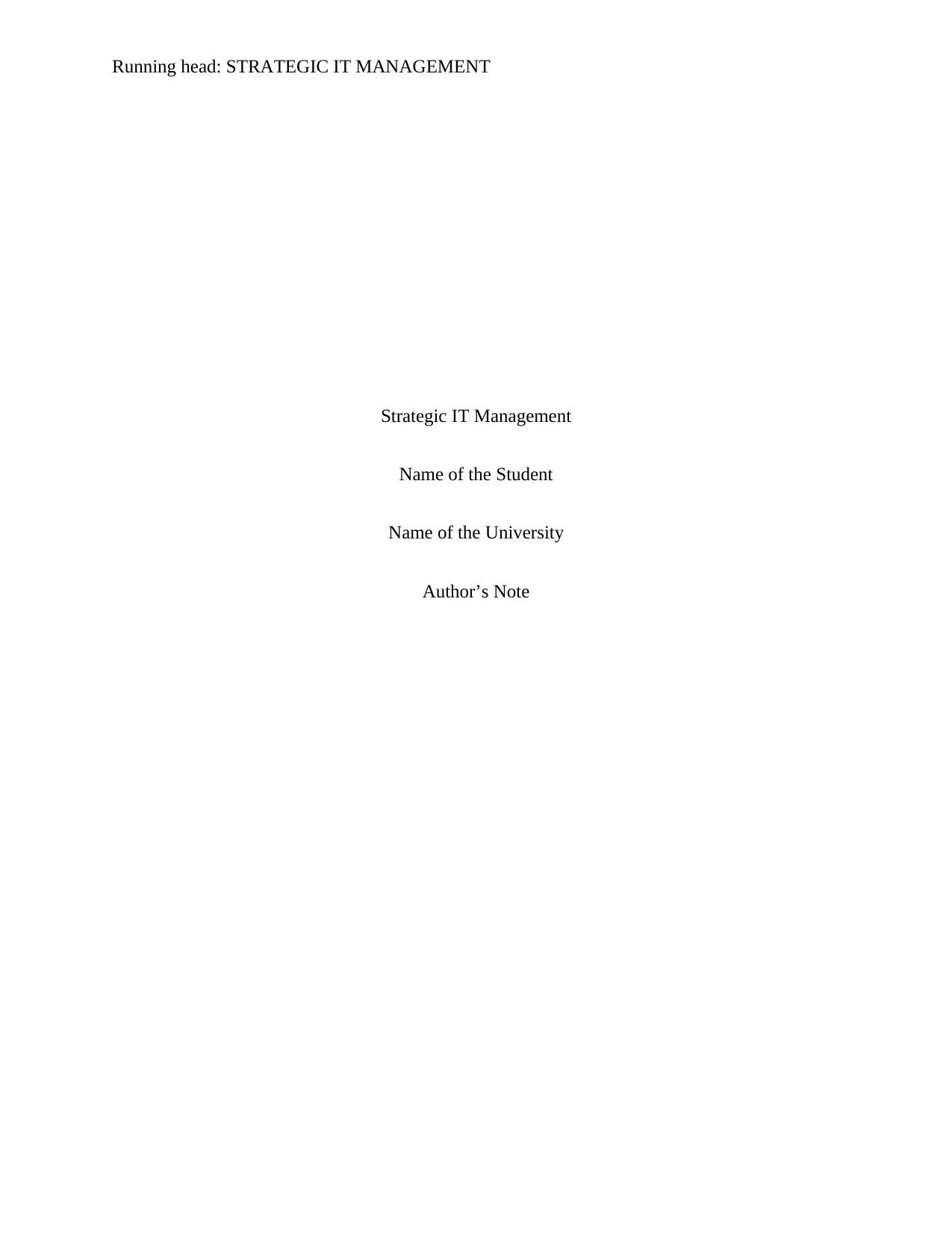
Running head: STRATEGIC IT MANAGEMENT
Strategic IT Management
Name of the Student
Name of the University
Author’s Note
Strategic IT Management
Name of the Student
Name of the University
Author’s Note
Secure Best Marks with AI Grader
Need help grading? Try our AI Grader for instant feedback on your assignments.
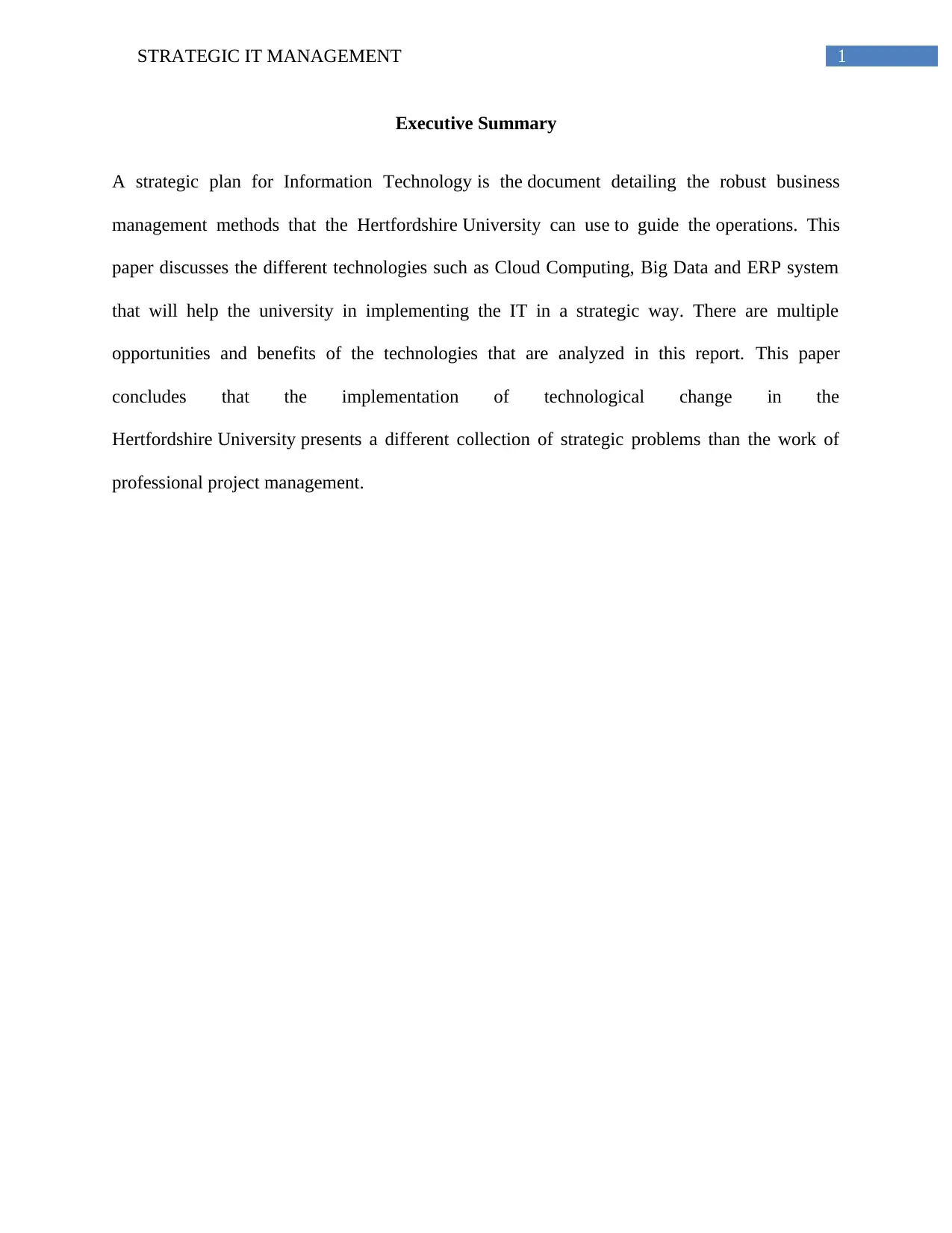
1STRATEGIC IT MANAGEMENT
Executive Summary
A strategic plan for Information Technology is the document detailing the robust business
management methods that the Hertfordshire University can use to guide the operations. This
paper discusses the different technologies such as Cloud Computing, Big Data and ERP system
that will help the university in implementing the IT in a strategic way. There are multiple
opportunities and benefits of the technologies that are analyzed in this report. This paper
concludes that the implementation of technological change in the
Hertfordshire University presents a different collection of strategic problems than the work of
professional project management.
Executive Summary
A strategic plan for Information Technology is the document detailing the robust business
management methods that the Hertfordshire University can use to guide the operations. This
paper discusses the different technologies such as Cloud Computing, Big Data and ERP system
that will help the university in implementing the IT in a strategic way. There are multiple
opportunities and benefits of the technologies that are analyzed in this report. This paper
concludes that the implementation of technological change in the
Hertfordshire University presents a different collection of strategic problems than the work of
professional project management.
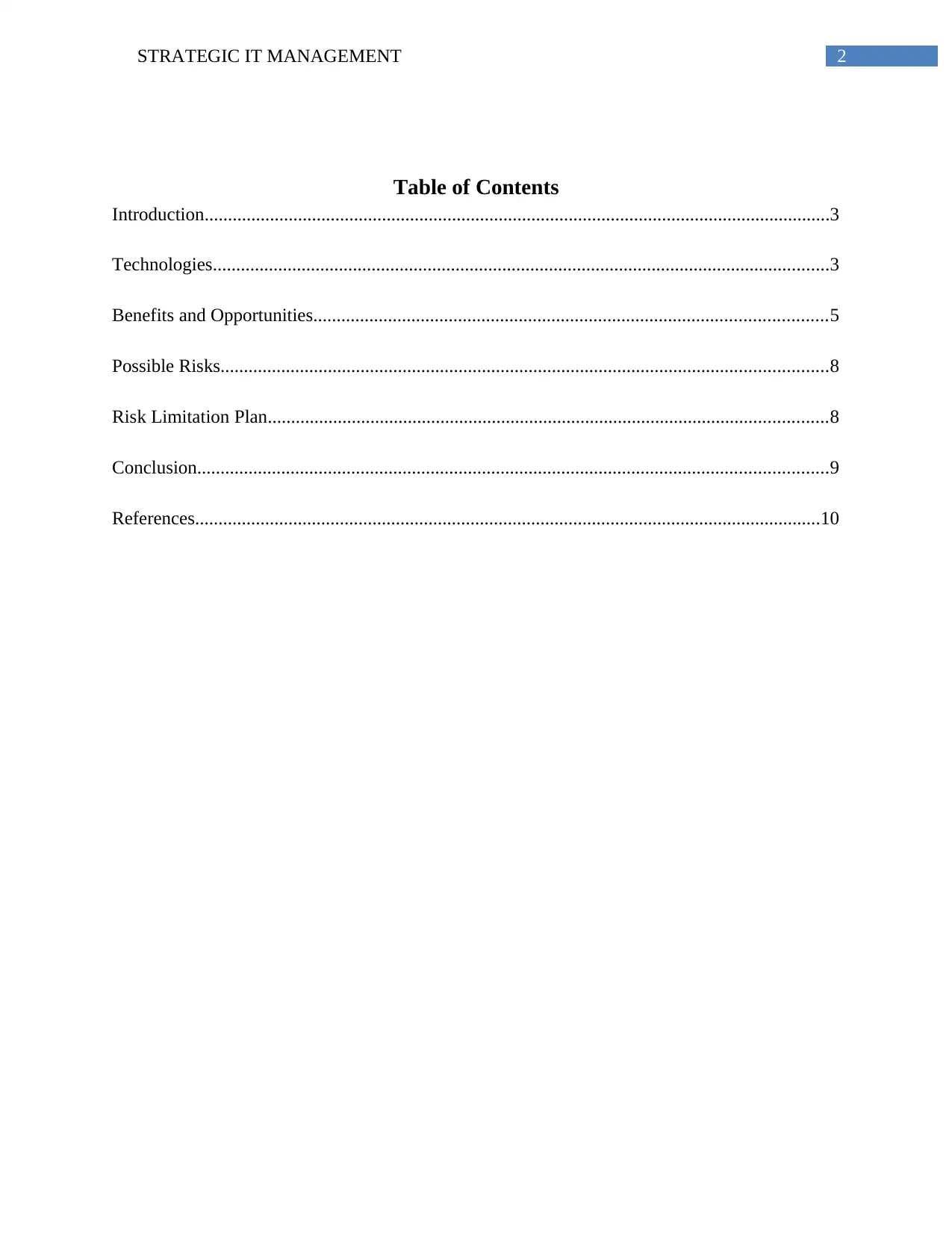
2STRATEGIC IT MANAGEMENT
Table of Contents
Introduction......................................................................................................................................3
Technologies....................................................................................................................................3
Benefits and Opportunities..............................................................................................................5
Possible Risks..................................................................................................................................8
Risk Limitation Plan........................................................................................................................8
Conclusion.......................................................................................................................................9
References......................................................................................................................................10
Table of Contents
Introduction......................................................................................................................................3
Technologies....................................................................................................................................3
Benefits and Opportunities..............................................................................................................5
Possible Risks..................................................................................................................................8
Risk Limitation Plan........................................................................................................................8
Conclusion.......................................................................................................................................9
References......................................................................................................................................10
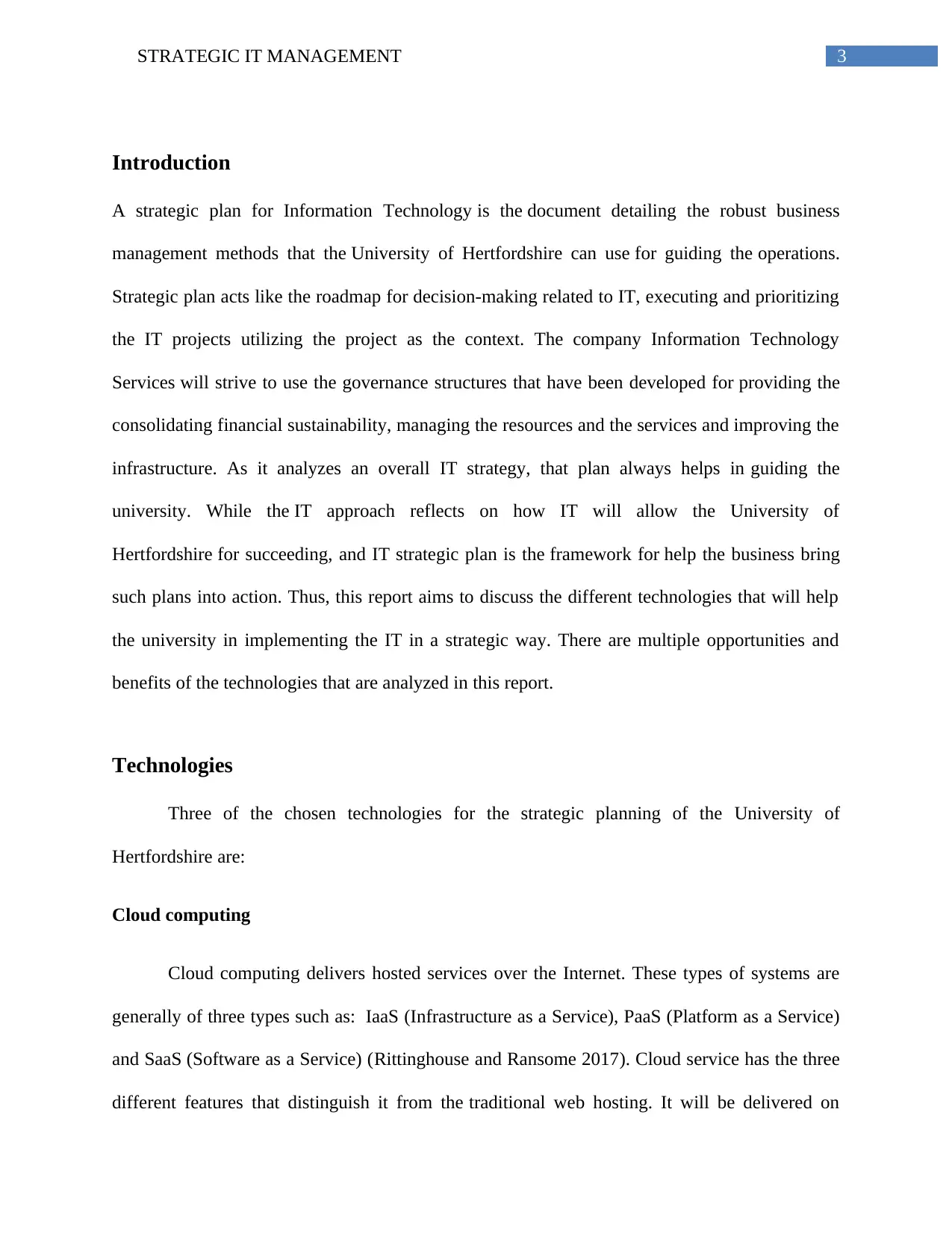
3STRATEGIC IT MANAGEMENT
Introduction
A strategic plan for Information Technology is the document detailing the robust business
management methods that the University of Hertfordshire can use for guiding the operations.
Strategic plan acts like the roadmap for decision-making related to IT, executing and prioritizing
the IT projects utilizing the project as the context. The company Information Technology
Services will strive to use the governance structures that have been developed for providing the
consolidating financial sustainability, managing the resources and the services and improving the
infrastructure. As it analyzes an overall IT strategy, that plan always helps in guiding the
university. While the IT approach reflects on how IT will allow the University of
Hertfordshire for succeeding, and IT strategic plan is the framework for help the business bring
such plans into action. Thus, this report aims to discuss the different technologies that will help
the university in implementing the IT in a strategic way. There are multiple opportunities and
benefits of the technologies that are analyzed in this report.
Technologies
Three of the chosen technologies for the strategic planning of the University of
Hertfordshire are:
Cloud computing
Cloud computing delivers hosted services over the Internet. These types of systems are
generally of three types such as: IaaS (Infrastructure as a Service), PaaS (Platform as a Service)
and SaaS (Software as a Service) (Rittinghouse and Ransome 2017). Cloud service has the three
different features that distinguish it from the traditional web hosting. It will be delivered on
Introduction
A strategic plan for Information Technology is the document detailing the robust business
management methods that the University of Hertfordshire can use for guiding the operations.
Strategic plan acts like the roadmap for decision-making related to IT, executing and prioritizing
the IT projects utilizing the project as the context. The company Information Technology
Services will strive to use the governance structures that have been developed for providing the
consolidating financial sustainability, managing the resources and the services and improving the
infrastructure. As it analyzes an overall IT strategy, that plan always helps in guiding the
university. While the IT approach reflects on how IT will allow the University of
Hertfordshire for succeeding, and IT strategic plan is the framework for help the business bring
such plans into action. Thus, this report aims to discuss the different technologies that will help
the university in implementing the IT in a strategic way. There are multiple opportunities and
benefits of the technologies that are analyzed in this report.
Technologies
Three of the chosen technologies for the strategic planning of the University of
Hertfordshire are:
Cloud computing
Cloud computing delivers hosted services over the Internet. These types of systems are
generally of three types such as: IaaS (Infrastructure as a Service), PaaS (Platform as a Service)
and SaaS (Software as a Service) (Rittinghouse and Ransome 2017). Cloud service has the three
different features that distinguish it from the traditional web hosting. It will be delivered on
Secure Best Marks with AI Grader
Need help grading? Try our AI Grader for instant feedback on your assignments.
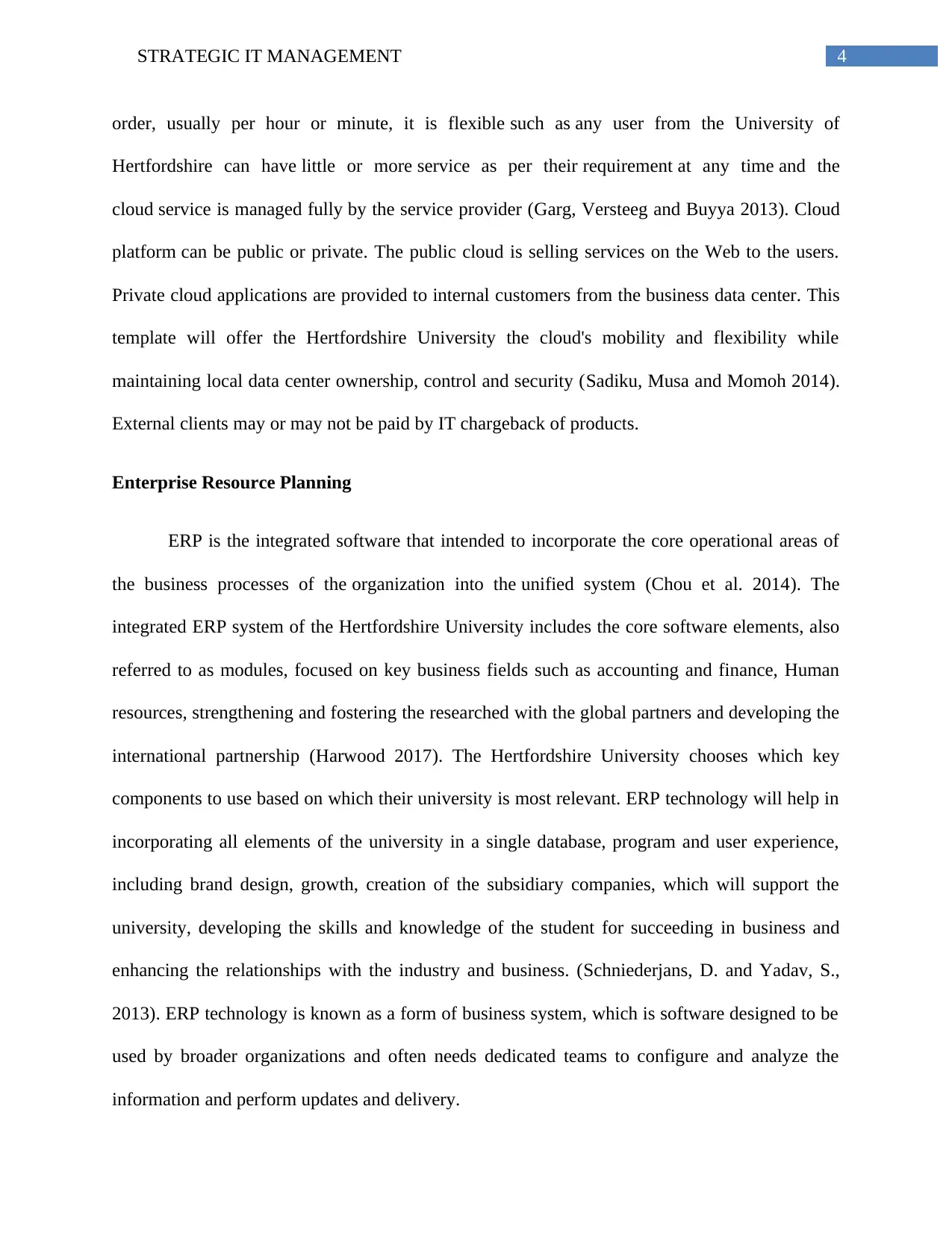
4STRATEGIC IT MANAGEMENT
order, usually per hour or minute, it is flexible such as any user from the University of
Hertfordshire can have little or more service as per their requirement at any time and the
cloud service is managed fully by the service provider (Garg, Versteeg and Buyya 2013). Cloud
platform can be public or private. The public cloud is selling services on the Web to the users.
Private cloud applications are provided to internal customers from the business data center. This
template will offer the Hertfordshire University the cloud's mobility and flexibility while
maintaining local data center ownership, control and security (Sadiku, Musa and Momoh 2014).
External clients may or may not be paid by IT chargeback of products.
Enterprise Resource Planning
ERP is the integrated software that intended to incorporate the core operational areas of
the business processes of the organization into the unified system (Chou et al. 2014). The
integrated ERP system of the Hertfordshire University includes the core software elements, also
referred to as modules, focused on key business fields such as accounting and finance, Human
resources, strengthening and fostering the researched with the global partners and developing the
international partnership (Harwood 2017). The Hertfordshire University chooses which key
components to use based on which their university is most relevant. ERP technology will help in
incorporating all elements of the university in a single database, program and user experience,
including brand design, growth, creation of the subsidiary companies, which will support the
university, developing the skills and knowledge of the student for succeeding in business and
enhancing the relationships with the industry and business. (Schniederjans, D. and Yadav, S.,
2013). ERP technology is known as a form of business system, which is software designed to be
used by broader organizations and often needs dedicated teams to configure and analyze the
information and perform updates and delivery.
order, usually per hour or minute, it is flexible such as any user from the University of
Hertfordshire can have little or more service as per their requirement at any time and the
cloud service is managed fully by the service provider (Garg, Versteeg and Buyya 2013). Cloud
platform can be public or private. The public cloud is selling services on the Web to the users.
Private cloud applications are provided to internal customers from the business data center. This
template will offer the Hertfordshire University the cloud's mobility and flexibility while
maintaining local data center ownership, control and security (Sadiku, Musa and Momoh 2014).
External clients may or may not be paid by IT chargeback of products.
Enterprise Resource Planning
ERP is the integrated software that intended to incorporate the core operational areas of
the business processes of the organization into the unified system (Chou et al. 2014). The
integrated ERP system of the Hertfordshire University includes the core software elements, also
referred to as modules, focused on key business fields such as accounting and finance, Human
resources, strengthening and fostering the researched with the global partners and developing the
international partnership (Harwood 2017). The Hertfordshire University chooses which key
components to use based on which their university is most relevant. ERP technology will help in
incorporating all elements of the university in a single database, program and user experience,
including brand design, growth, creation of the subsidiary companies, which will support the
university, developing the skills and knowledge of the student for succeeding in business and
enhancing the relationships with the industry and business. (Schniederjans, D. and Yadav, S.,
2013). ERP technology is known as a form of business system, which is software designed to be
used by broader organizations and often needs dedicated teams to configure and analyze the
information and perform updates and delivery.
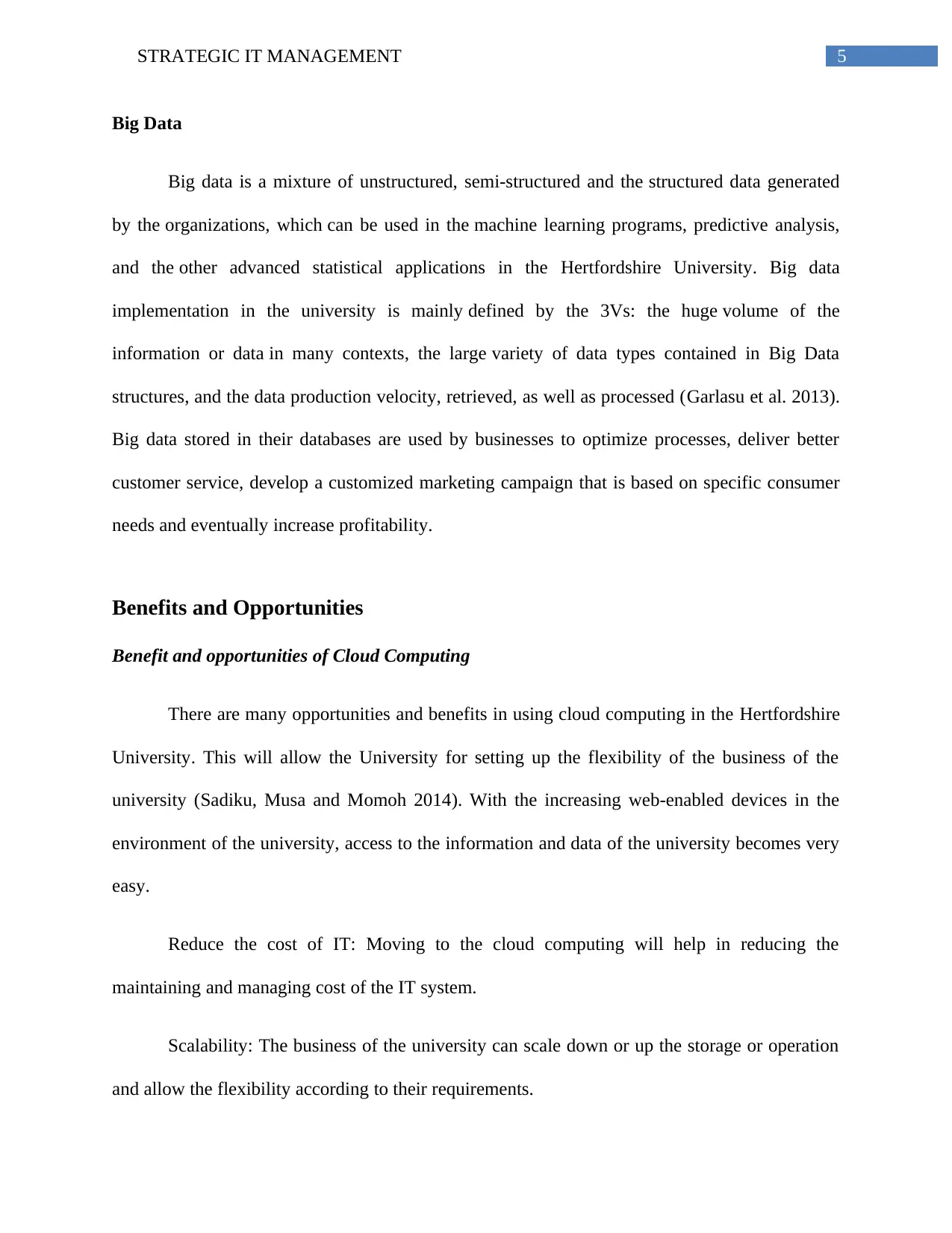
5STRATEGIC IT MANAGEMENT
Big Data
Big data is a mixture of unstructured, semi-structured and the structured data generated
by the organizations, which can be used in the machine learning programs, predictive analysis,
and the other advanced statistical applications in the Hertfordshire University. Big data
implementation in the university is mainly defined by the 3Vs: the huge volume of the
information or data in many contexts, the large variety of data types contained in Big Data
structures, and the data production velocity, retrieved, as well as processed (Garlasu et al. 2013).
Big data stored in their databases are used by businesses to optimize processes, deliver better
customer service, develop a customized marketing campaign that is based on specific consumer
needs and eventually increase profitability.
Benefits and Opportunities
Benefit and opportunities of Cloud Computing
There are many opportunities and benefits in using cloud computing in the Hertfordshire
University. This will allow the University for setting up the flexibility of the business of the
university (Sadiku, Musa and Momoh 2014). With the increasing web-enabled devices in the
environment of the university, access to the information and data of the university becomes very
easy.
Reduce the cost of IT: Moving to the cloud computing will help in reducing the
maintaining and managing cost of the IT system.
Scalability: The business of the university can scale down or up the storage or operation
and allow the flexibility according to their requirements.
Big Data
Big data is a mixture of unstructured, semi-structured and the structured data generated
by the organizations, which can be used in the machine learning programs, predictive analysis,
and the other advanced statistical applications in the Hertfordshire University. Big data
implementation in the university is mainly defined by the 3Vs: the huge volume of the
information or data in many contexts, the large variety of data types contained in Big Data
structures, and the data production velocity, retrieved, as well as processed (Garlasu et al. 2013).
Big data stored in their databases are used by businesses to optimize processes, deliver better
customer service, develop a customized marketing campaign that is based on specific consumer
needs and eventually increase profitability.
Benefits and Opportunities
Benefit and opportunities of Cloud Computing
There are many opportunities and benefits in using cloud computing in the Hertfordshire
University. This will allow the University for setting up the flexibility of the business of the
university (Sadiku, Musa and Momoh 2014). With the increasing web-enabled devices in the
environment of the university, access to the information and data of the university becomes very
easy.
Reduce the cost of IT: Moving to the cloud computing will help in reducing the
maintaining and managing cost of the IT system.
Scalability: The business of the university can scale down or up the storage or operation
and allow the flexibility according to their requirements.
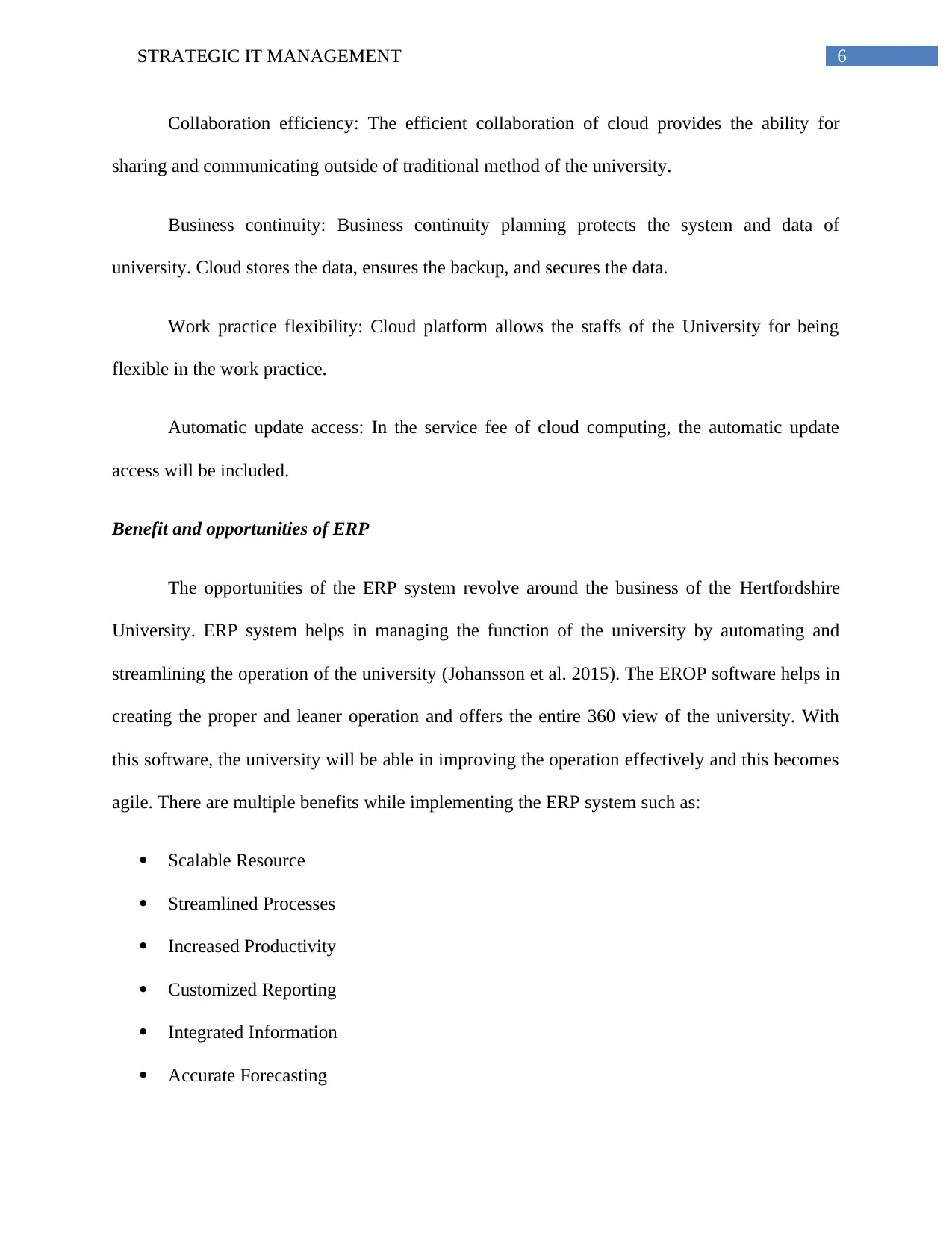
6STRATEGIC IT MANAGEMENT
Collaboration efficiency: The efficient collaboration of cloud provides the ability for
sharing and communicating outside of traditional method of the university.
Business continuity: Business continuity planning protects the system and data of
university. Cloud stores the data, ensures the backup, and secures the data.
Work practice flexibility: Cloud platform allows the staffs of the University for being
flexible in the work practice.
Automatic update access: In the service fee of cloud computing, the automatic update
access will be included.
Benefit and opportunities of ERP
The opportunities of the ERP system revolve around the business of the Hertfordshire
University. ERP system helps in managing the function of the university by automating and
streamlining the operation of the university (Johansson et al. 2015). The EROP software helps in
creating the proper and leaner operation and offers the entire 360 view of the university. With
this software, the university will be able in improving the operation effectively and this becomes
agile. There are multiple benefits while implementing the ERP system such as:
Scalable Resource
Streamlined Processes
Increased Productivity
Customized Reporting
Integrated Information
Accurate Forecasting
Collaboration efficiency: The efficient collaboration of cloud provides the ability for
sharing and communicating outside of traditional method of the university.
Business continuity: Business continuity planning protects the system and data of
university. Cloud stores the data, ensures the backup, and secures the data.
Work practice flexibility: Cloud platform allows the staffs of the University for being
flexible in the work practice.
Automatic update access: In the service fee of cloud computing, the automatic update
access will be included.
Benefit and opportunities of ERP
The opportunities of the ERP system revolve around the business of the Hertfordshire
University. ERP system helps in managing the function of the university by automating and
streamlining the operation of the university (Johansson et al. 2015). The EROP software helps in
creating the proper and leaner operation and offers the entire 360 view of the university. With
this software, the university will be able in improving the operation effectively and this becomes
agile. There are multiple benefits while implementing the ERP system such as:
Scalable Resource
Streamlined Processes
Increased Productivity
Customized Reporting
Integrated Information
Accurate Forecasting
Paraphrase This Document
Need a fresh take? Get an instant paraphrase of this document with our AI Paraphraser
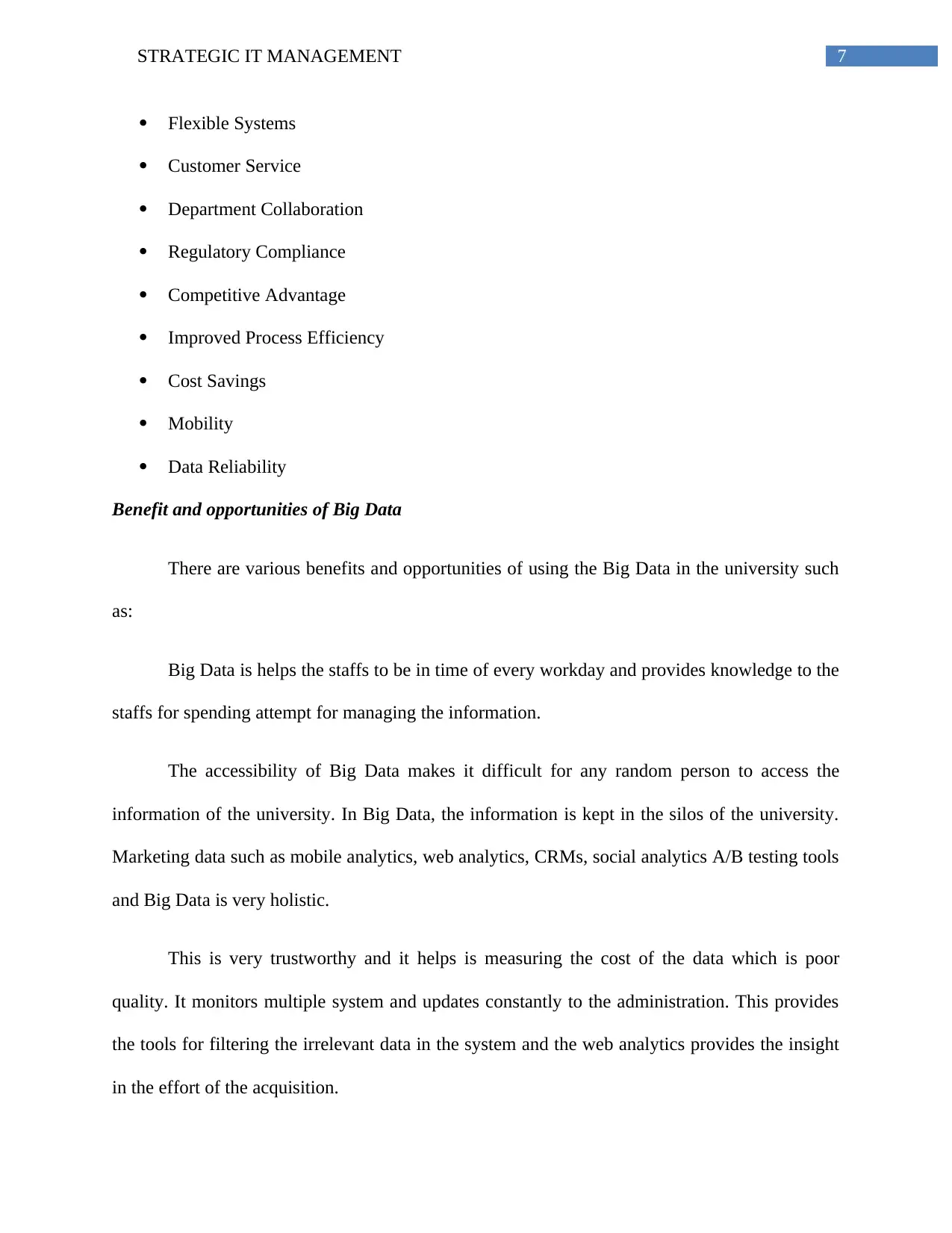
7STRATEGIC IT MANAGEMENT
Flexible Systems
Customer Service
Department Collaboration
Regulatory Compliance
Competitive Advantage
Improved Process Efficiency
Cost Savings
Mobility
Data Reliability
Benefit and opportunities of Big Data
There are various benefits and opportunities of using the Big Data in the university such
as:
Big Data is helps the staffs to be in time of every workday and provides knowledge to the
staffs for spending attempt for managing the information.
The accessibility of Big Data makes it difficult for any random person to access the
information of the university. In Big Data, the information is kept in the silos of the university.
Marketing data such as mobile analytics, web analytics, CRMs, social analytics A/B testing tools
and Big Data is very holistic.
This is very trustworthy and it helps is measuring the cost of the data which is poor
quality. It monitors multiple system and updates constantly to the administration. This provides
the tools for filtering the irrelevant data in the system and the web analytics provides the insight
in the effort of the acquisition.
Flexible Systems
Customer Service
Department Collaboration
Regulatory Compliance
Competitive Advantage
Improved Process Efficiency
Cost Savings
Mobility
Data Reliability
Benefit and opportunities of Big Data
There are various benefits and opportunities of using the Big Data in the university such
as:
Big Data is helps the staffs to be in time of every workday and provides knowledge to the
staffs for spending attempt for managing the information.
The accessibility of Big Data makes it difficult for any random person to access the
information of the university. In Big Data, the information is kept in the silos of the university.
Marketing data such as mobile analytics, web analytics, CRMs, social analytics A/B testing tools
and Big Data is very holistic.
This is very trustworthy and it helps is measuring the cost of the data which is poor
quality. It monitors multiple system and updates constantly to the administration. This provides
the tools for filtering the irrelevant data in the system and the web analytics provides the insight
in the effort of the acquisition.
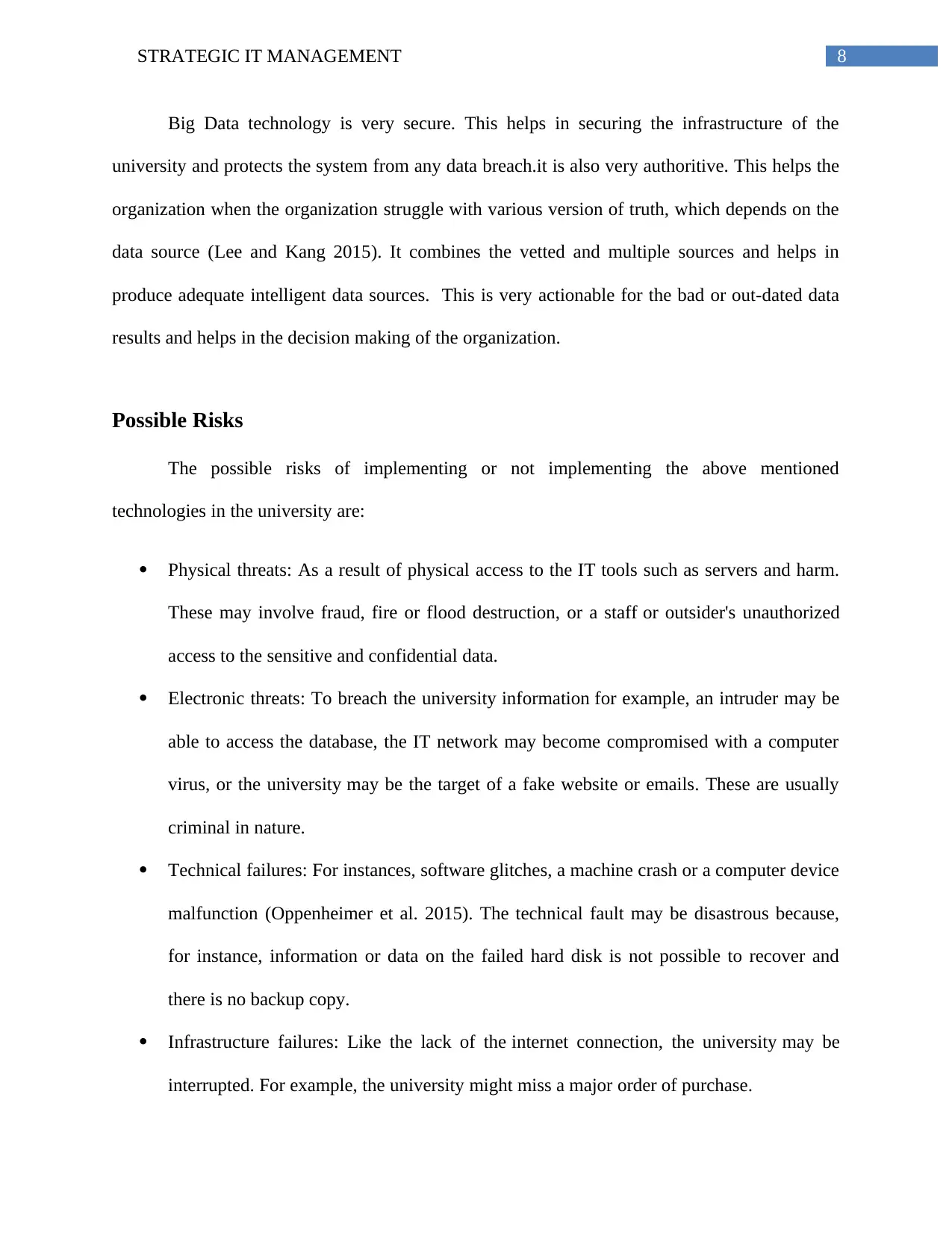
8STRATEGIC IT MANAGEMENT
Big Data technology is very secure. This helps in securing the infrastructure of the
university and protects the system from any data breach.it is also very authoritive. This helps the
organization when the organization struggle with various version of truth, which depends on the
data source (Lee and Kang 2015). It combines the vetted and multiple sources and helps in
produce adequate intelligent data sources. This is very actionable for the bad or out-dated data
results and helps in the decision making of the organization.
Possible Risks
The possible risks of implementing or not implementing the above mentioned
technologies in the university are:
Physical threats: As a result of physical access to the IT tools such as servers and harm.
These may involve fraud, fire or flood destruction, or a staff or outsider's unauthorized
access to the sensitive and confidential data.
Electronic threats: To breach the university information for example, an intruder may be
able to access the database, the IT network may become compromised with a computer
virus, or the university may be the target of a fake website or emails. These are usually
criminal in nature.
Technical failures: For instances, software glitches, a machine crash or a computer device
malfunction (Oppenheimer et al. 2015). The technical fault may be disastrous because,
for instance, information or data on the failed hard disk is not possible to recover and
there is no backup copy.
Infrastructure failures: Like the lack of the internet connection, the university may be
interrupted. For example, the university might miss a major order of purchase.
Big Data technology is very secure. This helps in securing the infrastructure of the
university and protects the system from any data breach.it is also very authoritive. This helps the
organization when the organization struggle with various version of truth, which depends on the
data source (Lee and Kang 2015). It combines the vetted and multiple sources and helps in
produce adequate intelligent data sources. This is very actionable for the bad or out-dated data
results and helps in the decision making of the organization.
Possible Risks
The possible risks of implementing or not implementing the above mentioned
technologies in the university are:
Physical threats: As a result of physical access to the IT tools such as servers and harm.
These may involve fraud, fire or flood destruction, or a staff or outsider's unauthorized
access to the sensitive and confidential data.
Electronic threats: To breach the university information for example, an intruder may be
able to access the database, the IT network may become compromised with a computer
virus, or the university may be the target of a fake website or emails. These are usually
criminal in nature.
Technical failures: For instances, software glitches, a machine crash or a computer device
malfunction (Oppenheimer et al. 2015). The technical fault may be disastrous because,
for instance, information or data on the failed hard disk is not possible to recover and
there is no backup copy.
Infrastructure failures: Like the lack of the internet connection, the university may be
interrupted. For example, the university might miss a major order of purchase.
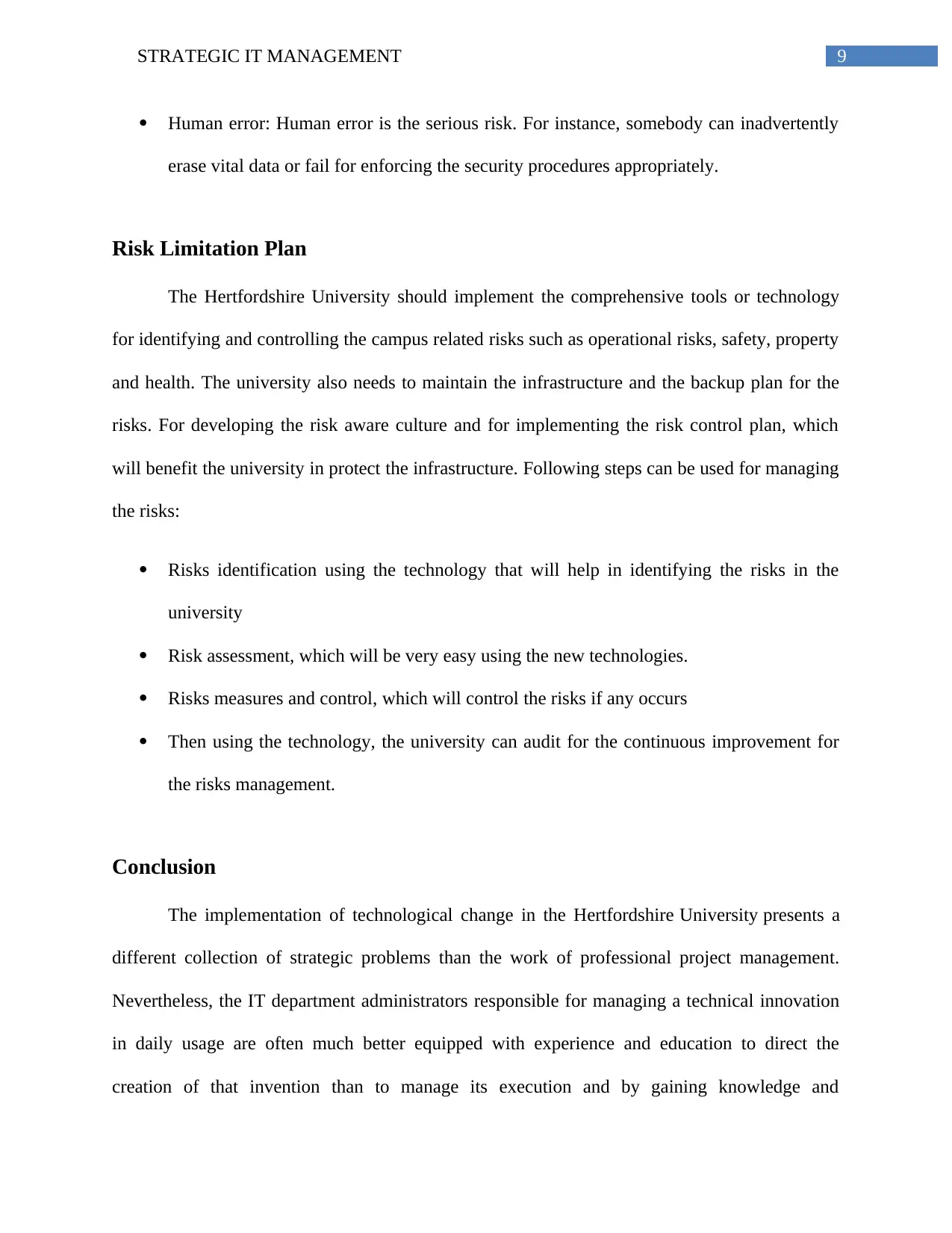
9STRATEGIC IT MANAGEMENT
Human error: Human error is the serious risk. For instance, somebody can inadvertently
erase vital data or fail for enforcing the security procedures appropriately.
Risk Limitation Plan
The Hertfordshire University should implement the comprehensive tools or technology
for identifying and controlling the campus related risks such as operational risks, safety, property
and health. The university also needs to maintain the infrastructure and the backup plan for the
risks. For developing the risk aware culture and for implementing the risk control plan, which
will benefit the university in protect the infrastructure. Following steps can be used for managing
the risks:
Risks identification using the technology that will help in identifying the risks in the
university
Risk assessment, which will be very easy using the new technologies.
Risks measures and control, which will control the risks if any occurs
Then using the technology, the university can audit for the continuous improvement for
the risks management.
Conclusion
The implementation of technological change in the Hertfordshire University presents a
different collection of strategic problems than the work of professional project management.
Nevertheless, the IT department administrators responsible for managing a technical innovation
in daily usage are often much better equipped with experience and education to direct the
creation of that invention than to manage its execution and by gaining knowledge and
Human error: Human error is the serious risk. For instance, somebody can inadvertently
erase vital data or fail for enforcing the security procedures appropriately.
Risk Limitation Plan
The Hertfordshire University should implement the comprehensive tools or technology
for identifying and controlling the campus related risks such as operational risks, safety, property
and health. The university also needs to maintain the infrastructure and the backup plan for the
risks. For developing the risk aware culture and for implementing the risk control plan, which
will benefit the university in protect the infrastructure. Following steps can be used for managing
the risks:
Risks identification using the technology that will help in identifying the risks in the
university
Risk assessment, which will be very easy using the new technologies.
Risks measures and control, which will control the risks if any occurs
Then using the technology, the university can audit for the continuous improvement for
the risks management.
Conclusion
The implementation of technological change in the Hertfordshire University presents a
different collection of strategic problems than the work of professional project management.
Nevertheless, the IT department administrators responsible for managing a technical innovation
in daily usage are often much better equipped with experience and education to direct the
creation of that invention than to manage its execution and by gaining knowledge and
Secure Best Marks with AI Grader
Need help grading? Try our AI Grader for instant feedback on your assignments.
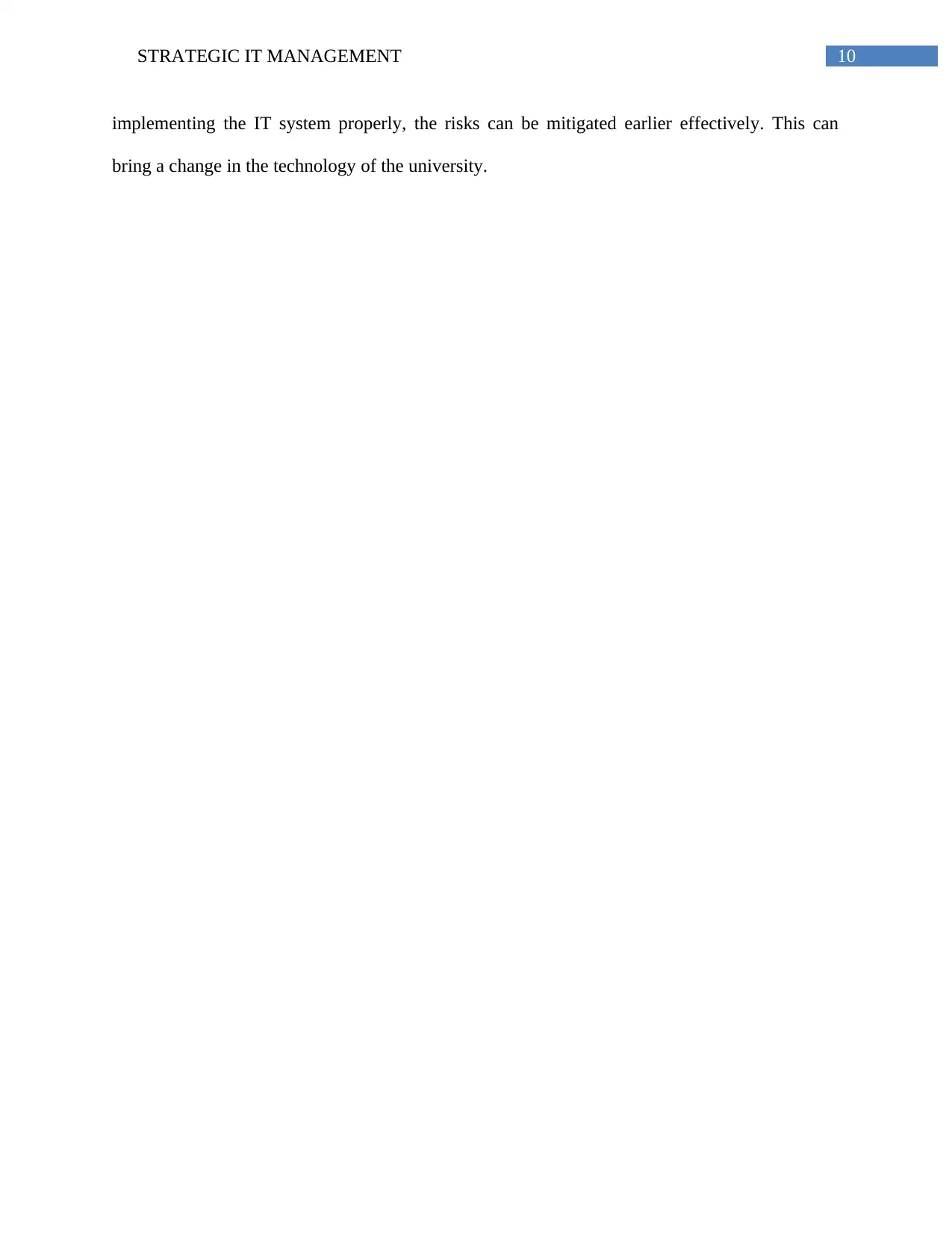
10STRATEGIC IT MANAGEMENT
implementing the IT system properly, the risks can be mitigated earlier effectively. This can
bring a change in the technology of the university.
implementing the IT system properly, the risks can be mitigated earlier effectively. This can
bring a change in the technology of the university.
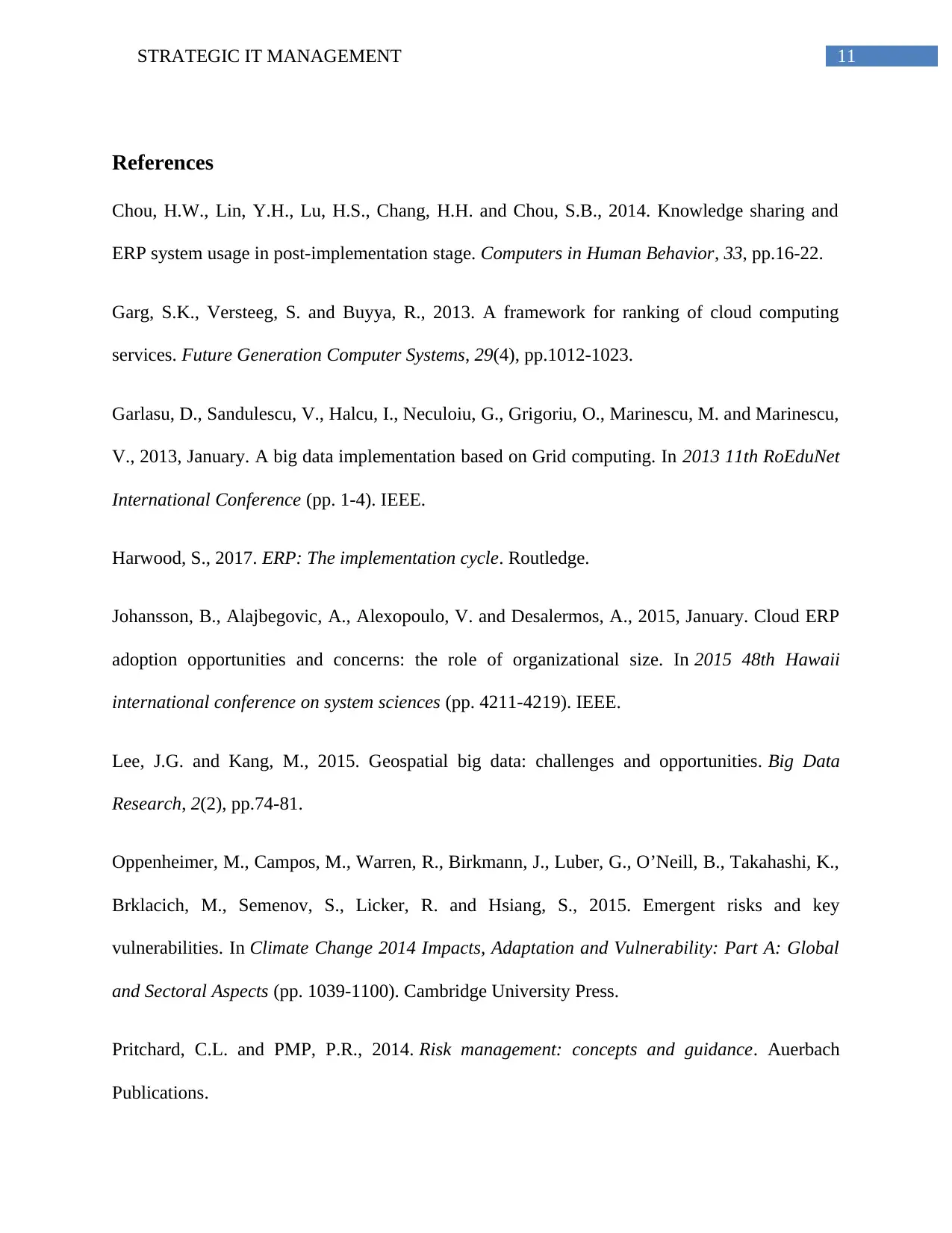
11STRATEGIC IT MANAGEMENT
References
Chou, H.W., Lin, Y.H., Lu, H.S., Chang, H.H. and Chou, S.B., 2014. Knowledge sharing and
ERP system usage in post-implementation stage. Computers in Human Behavior, 33, pp.16-22.
Garg, S.K., Versteeg, S. and Buyya, R., 2013. A framework for ranking of cloud computing
services. Future Generation Computer Systems, 29(4), pp.1012-1023.
Garlasu, D., Sandulescu, V., Halcu, I., Neculoiu, G., Grigoriu, O., Marinescu, M. and Marinescu,
V., 2013, January. A big data implementation based on Grid computing. In 2013 11th RoEduNet
International Conference (pp. 1-4). IEEE.
Harwood, S., 2017. ERP: The implementation cycle. Routledge.
Johansson, B., Alajbegovic, A., Alexopoulo, V. and Desalermos, A., 2015, January. Cloud ERP
adoption opportunities and concerns: the role of organizational size. In 2015 48th Hawaii
international conference on system sciences (pp. 4211-4219). IEEE.
Lee, J.G. and Kang, M., 2015. Geospatial big data: challenges and opportunities. Big Data
Research, 2(2), pp.74-81.
Oppenheimer, M., Campos, M., Warren, R., Birkmann, J., Luber, G., O’Neill, B., Takahashi, K.,
Brklacich, M., Semenov, S., Licker, R. and Hsiang, S., 2015. Emergent risks and key
vulnerabilities. In Climate Change 2014 Impacts, Adaptation and Vulnerability: Part A: Global
and Sectoral Aspects (pp. 1039-1100). Cambridge University Press.
Pritchard, C.L. and PMP, P.R., 2014. Risk management: concepts and guidance. Auerbach
Publications.
References
Chou, H.W., Lin, Y.H., Lu, H.S., Chang, H.H. and Chou, S.B., 2014. Knowledge sharing and
ERP system usage in post-implementation stage. Computers in Human Behavior, 33, pp.16-22.
Garg, S.K., Versteeg, S. and Buyya, R., 2013. A framework for ranking of cloud computing
services. Future Generation Computer Systems, 29(4), pp.1012-1023.
Garlasu, D., Sandulescu, V., Halcu, I., Neculoiu, G., Grigoriu, O., Marinescu, M. and Marinescu,
V., 2013, January. A big data implementation based on Grid computing. In 2013 11th RoEduNet
International Conference (pp. 1-4). IEEE.
Harwood, S., 2017. ERP: The implementation cycle. Routledge.
Johansson, B., Alajbegovic, A., Alexopoulo, V. and Desalermos, A., 2015, January. Cloud ERP
adoption opportunities and concerns: the role of organizational size. In 2015 48th Hawaii
international conference on system sciences (pp. 4211-4219). IEEE.
Lee, J.G. and Kang, M., 2015. Geospatial big data: challenges and opportunities. Big Data
Research, 2(2), pp.74-81.
Oppenheimer, M., Campos, M., Warren, R., Birkmann, J., Luber, G., O’Neill, B., Takahashi, K.,
Brklacich, M., Semenov, S., Licker, R. and Hsiang, S., 2015. Emergent risks and key
vulnerabilities. In Climate Change 2014 Impacts, Adaptation and Vulnerability: Part A: Global
and Sectoral Aspects (pp. 1039-1100). Cambridge University Press.
Pritchard, C.L. and PMP, P.R., 2014. Risk management: concepts and guidance. Auerbach
Publications.
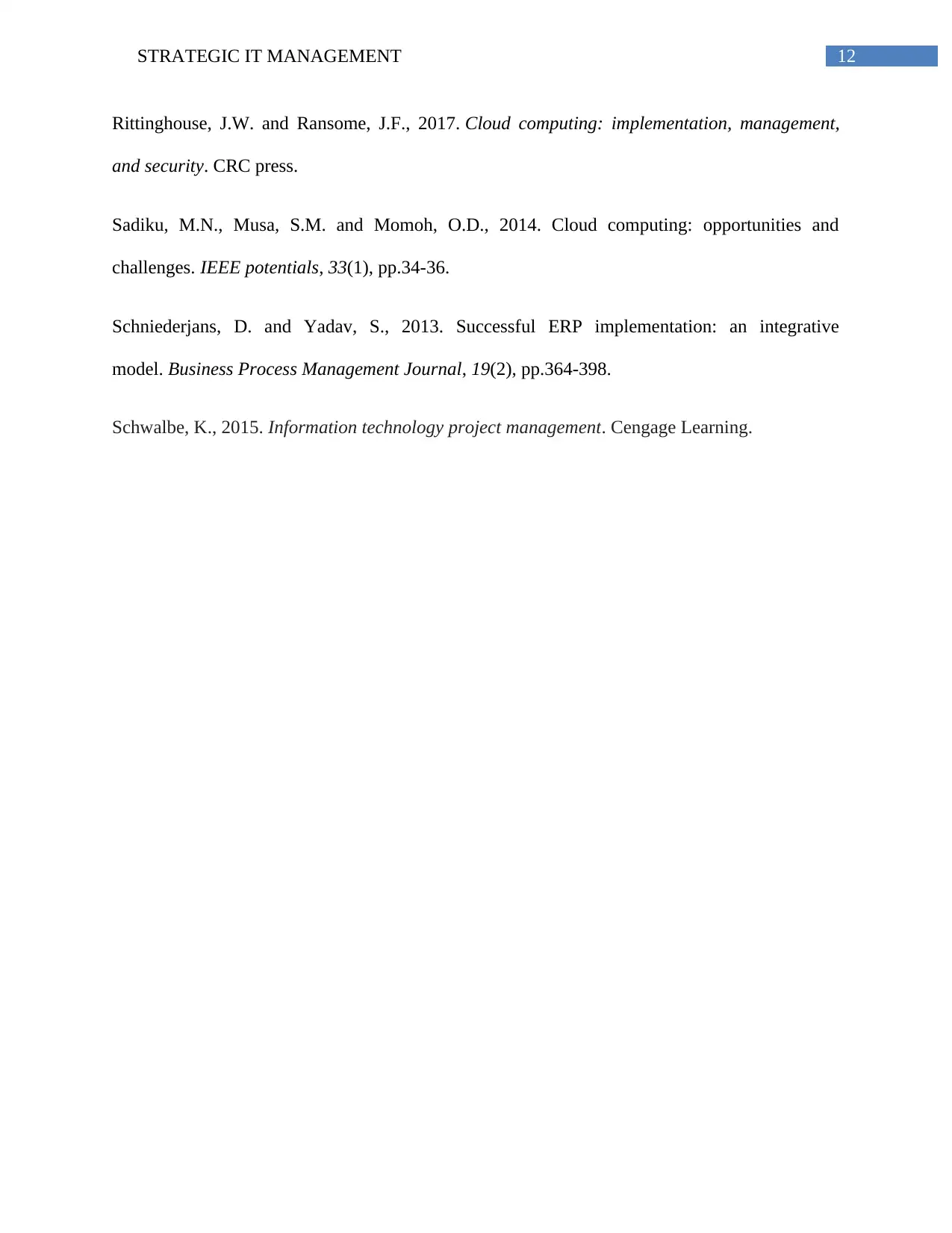
12STRATEGIC IT MANAGEMENT
Rittinghouse, J.W. and Ransome, J.F., 2017. Cloud computing: implementation, management,
and security. CRC press.
Sadiku, M.N., Musa, S.M. and Momoh, O.D., 2014. Cloud computing: opportunities and
challenges. IEEE potentials, 33(1), pp.34-36.
Schniederjans, D. and Yadav, S., 2013. Successful ERP implementation: an integrative
model. Business Process Management Journal, 19(2), pp.364-398.
Schwalbe, K., 2015. Information technology project management. Cengage Learning.
Rittinghouse, J.W. and Ransome, J.F., 2017. Cloud computing: implementation, management,
and security. CRC press.
Sadiku, M.N., Musa, S.M. and Momoh, O.D., 2014. Cloud computing: opportunities and
challenges. IEEE potentials, 33(1), pp.34-36.
Schniederjans, D. and Yadav, S., 2013. Successful ERP implementation: an integrative
model. Business Process Management Journal, 19(2), pp.364-398.
Schwalbe, K., 2015. Information technology project management. Cengage Learning.
1 out of 13
Related Documents
Your All-in-One AI-Powered Toolkit for Academic Success.
+13062052269
info@desklib.com
Available 24*7 on WhatsApp / Email
![[object Object]](/_next/static/media/star-bottom.7253800d.svg)
Unlock your academic potential
© 2024 | Zucol Services PVT LTD | All rights reserved.




